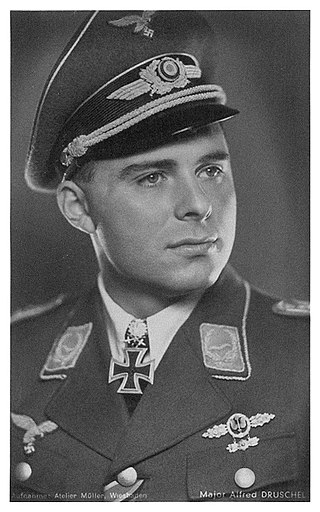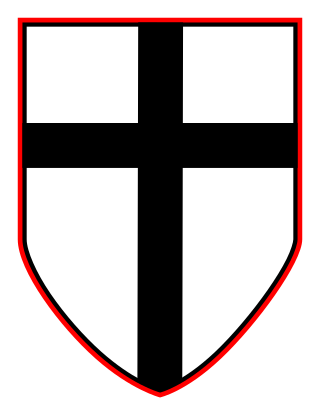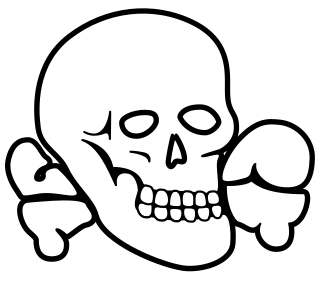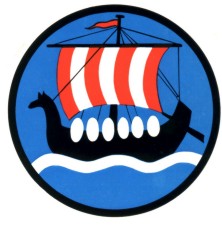
Alfred Druschel was a German Luftwaffe combat pilot during World War II. He was a recipient of the Knight's Cross of the Iron Cross with Oak Leaves and Swords of Nazi Germany.

Sturzkampfgeschwader 2 Immelmann was a Luftwaffe dive bombing squadron wing of World War II. It was named after the World War I aviator Max Immelmann. It served until its dissolution in October 1943. The wing operated the Junkers Ju 87 Stuka exclusively.
Schlachtgeschwader 2 Immelmann was a Luftwaffe dive-bomber wing of World War II. It was named after Max Immelmann, the first German pilot to earn the Pour le Mérite.

Kampfgeschwader 4 "General Wever" was a Luftwaffe bomber wing during World War II. The unit was formed in May 1939. The unit operated the Dornier Do 17, Junkers Ju 88 and Heinkel He 111 medium bombers, with later service on the Heinkel He 177 heavy bomber. The wing was named after General Walther Wever, the prime pre-war proponent for a strategic bombing capability for the Luftwaffe, who was killed in an aircraft accident in 1936.

Hans-Karl Stepp was a German ground attack pilot and wing commander during World War II. He was a recipient of the Knight's Cross of the Iron Cross with Oak Leaves, a grade of the highest award in the military and paramilitary forces of Nazi Germany during World War II.

Schlachtgeschwader 1 was a German Luftwaffe wing during World War II. It operated the Henschel Hs 123, Henschel Hs 129, Focke-Wulf Fw 190, and the Messerschmitt Bf 109.
Kampfgeschwader 51 "Edelweiss" (KG 51) was a Luftwaffe bomber wing during World War II.

Kampfgeschwader 76 was a Luftwaffe bomber Group during World War II. It was one of the few bomber groups that operated throughout the war.

Kampfgeschwader 54 "Totenkopf" was a Luftwaffe bomber wing during World War II. It served on nearly all the fronts in the European Theatre where the German Luftwaffe operated.

Kampfgeschwader 53 "Legion Condor" was a Luftwaffe bomber wing during World War II. Its units participated on all of the fronts in the European Theatre until it was disbanded in May 1945. At all times it operated the German bomber type Heinkel He 111. Only the 15th (kroat) Squadron of KG 53, established in Agram (Zagreb) July 1942, operated the Dornier Do 17 Z.

Hubertus Hitschhold was a German general and ground-attack pilot during World War II. He was a recipient of the Knight's Cross of the Iron Cross with Oak Leaves of Nazi Germany.

Kampfgeschwader 2Holzhammer was a Luftwaffe bomber unit during the Second World War. The unit was formed in May 1939. The unit operated the Dornier Do 17 light bomber, Dornier Do 217 and Junkers Ju 188 heavy bombers. During the course of the Second World War KG 2 lost 767 aircraft destroyed and 158 damaged. According to H.L. de Zeng at al, it suffered 1,908 personnel killed in action or missing in action and 214 as prisoners of war. Broken down further, for the duration of the war KG 2 lost 1,228 killed, 688 missing, 656 wounded and with 214 captured, for a total of 2,786 in both combat and non-combat operations.

Sturzkampfgeschwader 1 was a Luftwaffe dive bomber wing during World War II.

Sturzkampfgeschwader 77 (StG 77) was a Luftwaffe dive bomber wing during World War II. From the outbreak of war StG 77 distinguished itself in every Wehrmacht major operation until the Battle of Stalingrad in 1942. If the claims made by StG 77 are accurate, it inflicted more damage to enemy ground forces than any other wing. It operated the Junkers Ju 87 dive-bomber exclusively in the combat role. The Dornier Do 17 and Messerschmitt Bf 110 were both used in the air reconnaissance role.
'Kampfgeschwader' 27 Boelcke was a Luftwaffe medium bomber wing of World War II.
Schlachtgeschwader 10 was a close air support wing in the Luftwaffe of Nazi Germany during World War II. The Geschwader was formed on 18 October 1943 in Berdychiv from the Stab of Schnellkampfgeschwader 10. I. Gruppe formed from I./Schnellkampfgeschwader 2, II. Gruppe from IV./Schnellkampfgeschwader 10 and III. Gruppe from II./Sturzkampfgeschwader 77.

Sturzkampfgeschwader 3 was a Dive bomber wing in the German Luftwaffe during World War II and operated the Junkers Ju 87 Stuka.

Schlachtgeschwader 3 was a Luftwaffe close air support Geschwader during World War II. It was formed on 18 October 1943 in Eleusis from Sturzkampfgeschwader 3. A special detachment was formed 13 June 1944 to 13 August 1944 referred to as Detachment Kuhlmey. The detachment was built around elements of I./SG 3, I./SG 5, II./JG 54 and NaGr.1

Schnellkampfgeschwader 10 was a Luftwaffe fast bomber wing of the Second World War. The unit was initially created with three Gruppen (groups) in December 1942 at Saint-André-de-l'Eure Airport and augmented by a fourth group on 10 April 1943.

Kampfgeschwader 100 was a Luftwaffe medium and heavy bomber wing of World War II and the first military aviation unit to use a precision-guided munition in combat to sink a warship on 9 September 1943.
















